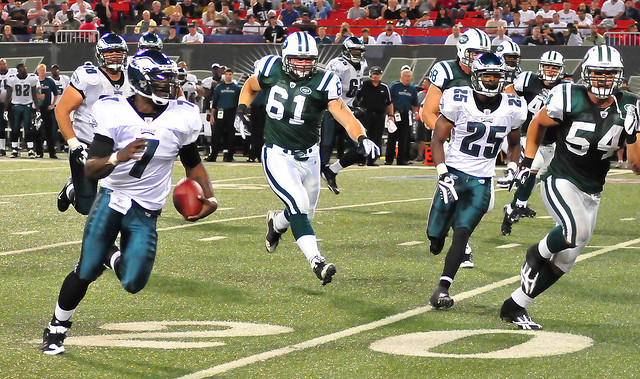High Frequency Training: Your Strength Building Solution
January 31, 2014
High-Frequency Training is a hotly debated topic.
Some “experts” say you should demolish every muscle once per week, blitzing the body part split. Others say focus on an upper-lower or total body split because training major movement patterns more frequently will stimulate faster gains in strength and size.
I’m with High-Frequency Training. Here’s Why.
Training Frequency the number of sessions performed per unit of time, is the most important training variable for building size, strength, and skill mastery for beginners.
For those looking to gain muscle and strength, frequent training is the premier and logical choice for the fastest gains. Unfortunately, most people still follow bodybuilding body-part split routines popularized in every fitness magazine over the last three decades. These routines aren’t ideal for anyone except high-level bodybuilders. Luckily, the workout you can download here will help you.
Consider the Following:
If you’re learning a new language is it best to study for five hours one day per week, or 45 minutes seven days per week?
Would you be stronger performing squats in 52 workouts per year or 104?
I would go with 45 minutes per day, seven days per week and 104 workouts without a doubt.
But Why?
Consistent exposure to stimuli is vital for learning new things and movement patterns.
The Research on High-Frequency Training
In 2000 the study Comparison of 1 Day and 3 Days Per Week of Equal-Volume Resistance Training in Experienced Subjects 25 experienced participants were randomly separated into training groups. Group one performed one day per week of strength training with three sets to failure, with rep ranges moving from three to ten reps per set.
Group two performed workouts three days per week with one set to failure per day while working in the same rep ranges. Volume was kept the exact same, yet group two had greater increases in both lean body mass and improved one-rep max strength. With total volume held constant, spreading the training frequency to three doses per week produced superior results in both strength and muscular hypertrophy.

In a 1997 study titled Isometric torso rotation strength: effect of training frequency on its development 33 men and 25 women were tested for rotational strength before and after 12 weeks of training. Groups were split into training groups that exercised one, two, or three times per week.
Although there were no major differences between groups training two or three times per week, strength was significantly increased compared to the one time per week training group. Once again, a higher frequency than one time per week was shown to improve strength gains.
In a 2010 study titled Anabolic processes in human skeletal muscle: restoring the identities of Growth Hormone and Testosterone, it was found that repeated phases of net protein balance, which can be generated in response to repeated bouts of resistance exercise and protein ingestion, underpins muscle hypertrophy.
This shows that frequent exposure to training increases protein synthesis at the cellular level, leading to greater amounts of muscle growth.
High-Frequency Training for Hypertrophy and Strength
Full body workouts are the premier and logical choice for beginners. The more muscle you stimulate frequently the more muscle and strength you’ll build, with three or four workouts per week being plenty.
To set up your own full-body workout start with a dynamic warm-up to activate muscles, lubricate joints, and prepare the body for activity.
Before hitting the weights start with some box jumps or medicine ball slams to fire up the central nervous system to lift more weight. Two or three sets of three to five reps should be plenty.
Pick an upper body push, an upper body pull and a compound lower body exercise.
This includes squats, lunges, deadlifts, bench presses, push-ups, chin-ups, rows, cleans, overhead presses, and glute bridges.
Stick with four or five sets of two to eight reps with one or two minutes of rest between sets. Multi-joint exercises should be practiced with a high training frequency and technically mastered for both safety and results.
Plan ten minutes (yes, only ten) at the end of your workout of free time to do things you want to do, whether it’s abs, biceps curls, or somersaults across the floor.
Have fun and enjoy yourself. I highly recommend a qualified coach to get you off on the right foot.
Upper/ Lower Splits
If you’ve been training for a solid year while making significant strength gains you can get more creative.
I recommend intermediates move to an upper-lower split, with halves of the body being hit at least 48 hours apart. Pick two presses and two or three pulling exercises performed in alternative sets on upper body days. Always train strength first and add weight to the bar, but feel free to add in some higher rep work to build those “pretty bumps.”
According to The Mechanisms of Hypertrophy and Their Application to Resistance Training.” Chasing the pump is alright, as the accumulation of metabolites from exercise requires the use of anaerobic glycolysis resulting in the buildup of lactate, hydrogen ions, and other metabolites.

This metabolic stress leads to greater muscle fiber damage, furthering the need for tissue repair and nutrient shuttling to the source of damage.
Lower body workouts should be at least 48 hours apart as well, with 72 being ideal for maximum recovery.
Just like the upper body workouts train strength first and add weight to the bar, but feel free to add in some higher rep work to stimulate the metabolic environment to promote further muscle growth.
Here’s a sample lower body day: 1×10/each
- Walking knee hug
- Cradle walk
- Straight leg march
- Dynamic quad stretch
- Forward lunge
- Reverse lunge w/reach
- Spiderman’s
- Sub-Scap Push-Ups
- Body Weight Squats
- Box Jump 3×3
Weight Room:
1.Front Squat 5×5
2a.Romanian Deadlift 4×8
2b. Side plank 4×30 seconds
3a. Bulgarian Split Squat 3×12-15
3b. Hanging leg raises 3×10-15
4. Free time/ intervals/ Pretty bumps
*Note: If you’re a competitive athlete this isn’t a program for you. You’ll need more specialization and movement included early in the session. Many athletes succeed with total body programs because they place a premium on recovery. Routines that train movements or muscles only one time per week are not optimal for high-performance strength development, especially for beginners. I recommend training each movement pattern at least twice per week for the best gains in strength, muscle, and performance.
Download the full workout here.
High Frequency Training for Athletes and Skill Mastery
“Practice doesn’t make perfect. Perfect practice makes perfect.” –Vince Lombardi
For learning a new movement or athletic skill the more frequently you practice the quicker it’s learned, eventually leading to unconscious competence—being able to perform a skill correctly without conscious thought.
Training skills to the point muscle memory is imperative for athlete success and transfer from the weight room. Practicing solid body position and movements like triple-extension to perfection will reinforce movement in the field of play.
These same principles apply to anyone learning a new skill or movement. The more frequently you practice perfect technique the faster the learning process and subsequent gains.
Movement skill development must be grooved correctly until it becomes automatic and follows the following continuum: (Landow, 2013) Unconscious Incompetence: Athlete looks clueless, unable to comprehend what is needed.Conscious Incompetence: Athlete understands what’s needed, unable to produce it.
Conscious Incompetence: Athlete can reproduce with much-needed concentration, but not in series.
Unconscious Competence: Automatic near perfection execution without thought.
Training for athletic gains is a process that can’t be served due justice in this post, but matching movement patterns to movements required in sport is a key step. (No, this doesn’t mean throwing 12lb baseballs.) For more in-depth sports performance specialization read this & this.
It’s a Wrap ( In Dr. Dre Voice)
The process of perfecting a skill, whether it’s shooting free throws or lifting technique, takes much practice. Total body and upper-lower training splits provide higher frequency training to maximize strength and muscle-building gains with compound lifts.
Put the leg extensions and seven variations of biceps curls on the back-burner and get back to what’s essential: high-frequency training with big movements, your strength building solution.
Resources:
McLester, J., Bishop, E., & Guilliams, M. (2000). Comparison of 1 day and 3 days per week of equal-volume resistance training in experienced subjects. The Journal of Strength and Conditioning Research, 14(3). Retrieved from http://journals.lww.com/nsca-jscr/Abstract/2000/08000/Comparison_of_1_Day_and_3_Days_Per_Week_of.6.aspx
DeMichele, P. L., Pollock, M. L., Graves, J. E., Foster, D. N., Carpenter, D., Garzarella, L., Brechue, W., & Fulton, M. (1997). Isometric torso rotation strength: effect of training frequency on its development. Archives of Physical Medicine and Rehabilitation, 78(1), 64-69. Retrieved from http://www.ncbi.nlm.nih.gov/pubmed/9014960
Landow, L. (2013, August). In Loren Landow (Chair). Train to win. Steadman Hawkins Sports Performance Train to win performance mentorship, Denver, Colorado.
Phillips, S., & West, D. (2010). Anabolic processes in human skeletal muscle: restoring the identities of growth hormone and testosterone. Physican and Sportsmedicine, 38(3), 97-104. doi: 10.3810/psm.2010.10.1814
Schoenfeld, Brad. “The Mechanisms of Hypertrophy and Their Application to Resistance Training.” Journal of Strength and Conditioning Research. 24.10 (2010): 2857. Web. 21 Nov. 2013.
photo credit: planetc1 via photopin cc
photo credit: Ed Yourdon via photopin cc











[…] 3) Increasing training frequency = increasing skill […]
[…] 3) Increasing training frequency = increasing skill acquisition/adaptation of neural movement patterns […]
[…] Related: High Frequency Training: Your Strength Building Solution […]
[…] Related: High Frequency Training […]